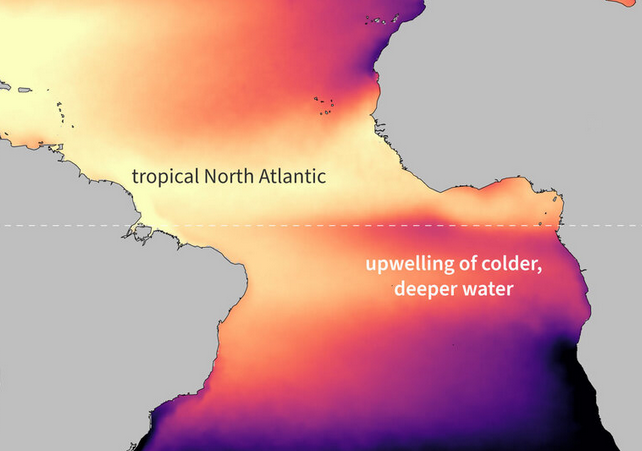Climate Phenomenon ‘Atlantic Niña’ is on the Verge of Developing

A few days ago, the publication NewScientist published an article with a click-bait headline: Part of the Atlantic is cooling at record speed, and nobody knows why.
It turns out the headline is not entirely…accurate. The temperature drop is part of a climate phenomenon known as the Atlantic Nodal Mode. The pattern is like the Pacific Ocean’s El Niño/La Niña cycles but more localized.
The natural climate pattern swings between cold and warm phases every few years. Sea surface temperatures (SST) in the eastern equatorial Atlantic have a somewhat surprising seasonal cycle. The warmest waters of the year occur in spring, while the coolest waters occur during the summer.
This summer cooling is because of winds that act on the ocean surface. Earth has a year-round rainfall band around the tropics. Driven by stronger solar heating, this rainfall band migrates northward during the summer in the Northern Hemisphere. The regular rainstorms draw in air from the southeast over the equatorial Atlantic.These steady southeasterly winds are strong enough to drag surface waters away from the equator, which brings relatively cold water from deeper ocean layers to the surface. This process, known as equatorial upwelling, forms a tongue of relatively cold water along the equatorial Atlantic during the summer months.However, every few years this cold tongue is substantially warmer or colder than average due to swings of the Atlantic zonal mode. Cold events are referred to as Atlantic Niñas; warm events are referred to as Atlantic Niños.
What perplexed scientists in this case is that the weaker southeasterly winds were not anticipated to be strong enough to initiate an Atlantic Niña.
The Atlantic cool pool of water typically develops when southeasterly winds flow into a band of persistent clouds in the intertropical convergence zone. The winds blowing over the ocean stir it up in a way that draws deeper cooler water to the surface.But meteorologists are perplexed about how this recent cool-down developed in overall weaker southeasterly trade winds near the equator which typically associated with reduced upwelling and warm anomalies.
Perhaps the most significant aspect of the developing Atlantic Niña is its potential impact on hurricane seasons. As hurricanes strengthen in warm waters and weaken in cool ones, this could be good news for Legal Insurrection fans along the Gulf Coast and Atlantic seaboard.
Hurricane forecasters have been worried about an especially active storm season because much of the North Atlantic has been extremely warm so far this year. But in the central Atlantic near the equator, sea-surface temperatures since the beginning of June (the start of hurricane season) have been between 0.9 and 1.8 degrees cooler than average for this time of year, according to the National Oceanic and Atmospheric Administration….“NOAA’s seasonal forecast of above-normal 2024 hurricane activity is based on expected La Niña conditions in the equatorial Pacific and warm ocean temperatures in the tropical North Atlantic,” NOAA scientist Franz Philip Tuchen wrote in an article for NOAA. “It will be interesting to monitor whether this Atlantic Niña fully develops, and if so, whether it has a dampening effect on hurricane activity as the season progresses.”
Clearly, climate is complex, and many factors beyond humans impact it. For an interesting review of why Atlantic waters are so warm, I would like to turn to climate scientists Jim Johnstone and Judith Curry for an insightful and rational review:
…[T]he extremely warm Atlantic SSTs this season is partly due to anomalous radiative warming of the surface. The twitterati have blamed many factors: CO2 emissions, lower amount of sulfate particles from clearer shipping fuels, Hunga-Tonga eruption, and low levels of African dust. And now the Canadian wildfires are a factor. These are all relatively minor factors compared to the dominant impact of variations in cloudiness.Atmospheric particulates have been reduced globally from cleaner fuels for shipping that were mandated in 2020, which produce fewer sulfate particles. Sulfate particles have a cooling effect by reflecting solar radiation. Cleaner air means less solar radiation is reflected, which contributes to surface warming.Indirect effects include darkening of subtropical clouds, through cloud microphysical effects, which reduces the reflectivity of these clouds. The ocean warming effect of this would be largest in the Northern Hemisphere, and subtropical clouds are most susceptible to this kind of modification. In the image below you can see the ship tracks from the brighter clouds, that are more reflective of solar radiation (these ship tracks have now been substantially reduced)Particulates from wildfire smoke has a similar effect on reducing the solar warming at the surface. My contacts in New York estimated that solar power production was cut in half during the period when a thick layer of smoke from the Canadian wildfires. For smoke trajectories into the North Atlantic, there will be variable surface cooling, depending on the smoke trajectory and optical depthAfrican dust storms have the same effect in terms of reflecting solar radiation and thus cooling the surface. Dust storms have been anomalously weak so far.
Whatever the reason for the development of the Atlantic Niña this year, as Curry notes, there is no climate emergency.
CLICK HERE FOR FULL VERSION OF THIS STORY